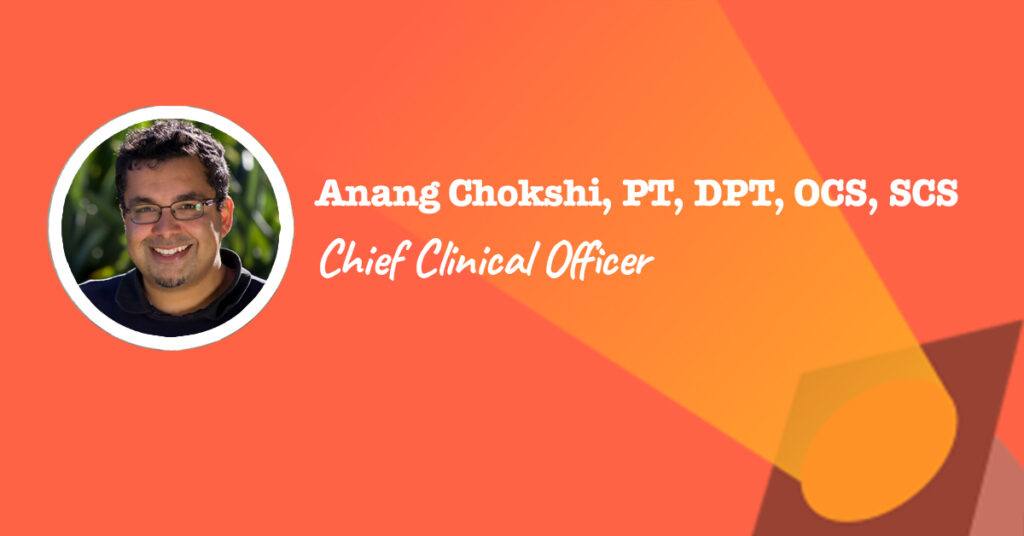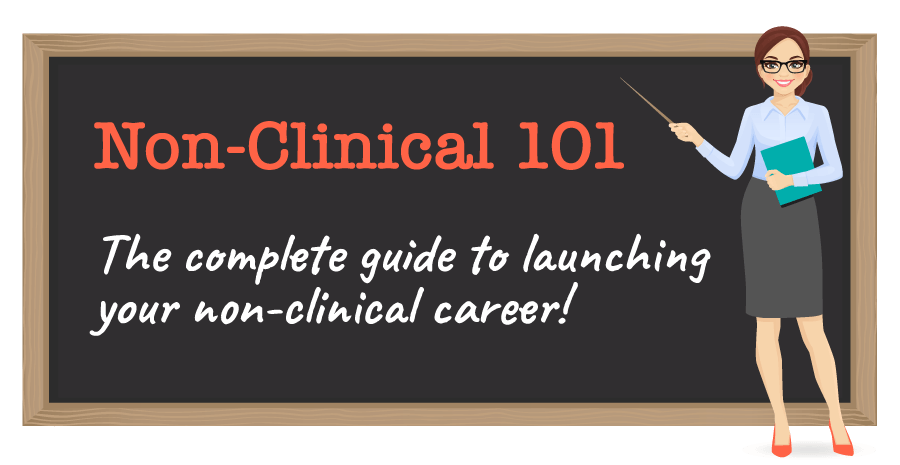This week’s non-clinical spotlight features Anang Chokshi, a PT who works as Chief Clinical Officer at IncludeHealth. I was lucky enough to meet Anang in person back when I was living in San Diego. He’s fantastic, and I know you’ll enjoy learning from him 🙂
This post may contain affiliate links or codes. This won’t increase your cost, but it helps keep TNCPT alive, and free of annoying ads! Thank you for your support. 🙂
What is your full name and title at your current job?
Anang Chokshi, PT, DPT, OCS, SCS
Chief Clinical Officer of IncludeHealth

Where are you located?
San Diego, CA
Where did you go to PT school, and what year did you graduate?
University of Michigan – Flint, 2004
What did you do when you first finished school?
After graduating, I moved to California and started to work at an orthopedic sports med clinic in Arcadia, CA.
I was there for 5 years before moving to another sports-ortho clinic in Westlake Village, CA. I eventually became clinic manager, and it was during my tenure at that clinic that I completed an orthopedic residency and then a sports fellowship program, while receiving my OCS and SCS ABPTS certifications.
What did you do after that, and for how long?
While working in my last clinic, I was approached to provide SME (subject matter expert) advice on a project within a research organization in San Diego looking at using sensors in helping to manage patients at home doing their physical therapy. This helped me to transition to my current role in digital healthcare using my PT degree and experience.
In addition to this, I also began teaching at local PT programs, helping students discover how to use their didactic learning for practical application and clinical decision-making.
What did you enjoy about your early roles? What didn’t you enjoy?
I always enjoyed learning from my colleagues and understanding that there were many different ways to help patients in their recovery. I liked pushing myself to add tools to my toolbox so I could offer personalized treatment to my patients based on their functional needs. I enjoyed translating these skills into helping patients recover and work toward their needs and goals. Working with patients and helping them was the biggest reward.
I think, like most clinicians, the main challenge for me was the paperwork and the day-to-day grind. I was fortunate to have had the ability to work with some great colleagues in the clinic, so it never felt like “work.” But I always wished we could just help people without having to be restricted by insurance, cost, and distance.
When and why did you realize you wanted to do something non-clinical?
I always enjoyed teaching and helping students bring their didactic learnings together in real-life situations to help them apply what they learned in school. I always thought I may go into teaching.
But then I was approached by a friend at a research organization. They were looking at the field of PT and how they could enhance it by helping patients outside the clinic using newly developed Microsoft sensor technology. This was back in 2011.
I became extremely curious about it…almost obsessed with it! I always offered my personal phone number to patients so that they could reach me at any time if they needed any assistance, and this was taking that concept to the next level. It was allowing me to help patients beyond the four walls of my clinic.
What are you doing these days?
I am now the Chief Clinical Officer of a company called IncludeHealth, Inc. based out of Columbus, Ohio (Go Wolverines!!).
I am responsible for helping to drive the product roadmap, while working closely with the product and technology teams. In this position, my team and I are responsible for helping our customers with implementing our technology within their clinical workflows.
Are you still treating patients, or are you solely non-clinical?
I am solely non-clinical now. I will do the occasional consult with patients, or with friends and family.
How long have you been in your Chief Clinical Officer role?
I recently joined this company in January of 2021. Prior to that, I was the Chief Clinical Officer of a company called Reflexion Health (based out of San Diego). This company was acquired by a large medical device company last year. In between that job and my current position, I also started a consulting company focused on the digital healthcare space.
How did you find your job?
I found my original position through a friend who worked at an organization that was looking into the field of PT and how to use technology within it. I became the SME and eventually the medical advisor.
As we worked on this project and concept, it eventually turned from an idea to a company as we were able to raise money to continue the project.
Did you do anything special to your resume and cover letter to land the job?
At the time, I did not. As my career has evolved in this space, I think the most valuable thing I learned and had to do was work on my networking skills.
When I first entered digital healthcare, it was in its infancy stage, but now this concept has exploded in the last 5-7 years.
There are many companies in digital healthcare out there that are being led by non-clinicians. Networking with people and leaders within these organizations—and demonstrating your knowledge of the field of PT and your willingness to look outside the traditional box—is the key.
What was the interview like for the Chief Clinical Officer (CCO) role?
In my original role when I transitioned from traditional practice to digital healthcare, the interview was based a little on my knowledge of the profession but focused more on the tangible skills of problem solving and collaboration.
They were looking for the ability to explain the complex workflows and decision making that happens in traditional practice—and then break them down so that non-clinicians/engineers/product owners etc. could understand them.
Did you get any special certifications or training along the way to help you get into your current role?
No
If you advanced through the company to get to where you are, what are some of the things you did to stand out, take initiative, and advance?
I started out as “PT Lead” and quickly moved to managing the clinical accounts as we onboarded our initial customers with our alpha and beta products.
Being able to work with the team to develop the clinical roadmap, while lending clinical relevance to the product in the eyes of the customers, was valuable. I showed I could help customers adopt and understand how to use the technology, and showing my value enabled me to eventually move into a VP role. Then, I was able to move into the CCO position.
Can you tell us a bit more about IncludeHealth?
At IncludeHealth, we are building products that help people to become active and healthy. We are helping people improve access to care through human design and technology. We are building products that can help the clinician manage patients in the clinic, community, and at home.
How have people reacted to you leaving patient care?
A lot of my close friends in the PT world were shocked and did not understand it at first. Many questioned why I would leave after working hard to achieve the OCS and SCS certifications and land my teaching roles.
Some colleagues even felt threatened by concept of what I was leaving to do back in 2012 (meaning telehealth PT).
What’s a typical day or week in the life like for you? What types of tasks and responsibilities fill your time?
My typical work week involves many meetings 🙂 I often meet with current and new customers, and I also provide clinical support to our sales teams on calls or in meetings. I tend to work closely with the product and technology team at the company to help with product roadmapping, requirement concepting, and testing.
What are some of the challenges of your role? What are the rewards?
One challenge I face in my role is trying to be in too many places at once. As the clinical SME, you can get dragged in multiple directions to help provide vision and support.
The reward is very similar to the clinic. It is about helping people recover. In the CCO role, I get to do this in a way that is tailored to patients’ specific functional needs.
How do you think working as a PT prepared you for this role? Which skills transferred?
I definitely gained people skills through communication and teaching while in the clinic. I think my time as a clinical PT honed my problem-solving skills, and it definitely helps me help others understand the importance and mindset of both clinicians and patients.
Roughly speaking, how are the hours and pay compared to patient care?
I think over time, there is an opportunity for this to be equal, if not more, than the traditional salary package one would receive in the clinic.
The hours can be long like the clinic, but you do have more flexibility. You’re usually not structured by patient appointments. Your work is more based on projects and collaborative meetings.
What type of person do you think would do well in your role?
- Someone open-minded
- Someone willing to embrace changes in their field.
- Someone able to take a step back look at the problem from a high level.
- Someone who can work with many different personality types. You’re working with a wide range of people day in and day out in the CCO role.
Do you work remotely or on-site?
Currently I am remote with some travel for work
Does your organization hire PT, OT, or SLP professionals into non-clinical roles?
In the future, we will be looking to bring on people in clinical roles for customer success and implementation.
Did you do anything special overall to get you where you are today?
I did read a lot of articles and papers on digital healthcare and sought out folks on LinkedIn to learn from their experiences.

What is a typical career path for someone in your role?
I would imagine starting as a SME makes the most sense. As you become more involved in the day-to-day operations, you will realize where your interest lies. You might be attracted to a product manager (or clinical product manager) vs. designer vs customer-facing role, depending on your strengths and skills.
Explore all sorts of non-clinical career paths in Non-Clinical 101, the comprehensive, fun, and inspiring course everyone is talking about!
What is next for you? What do you want to do with your career long-term?
I would like to help grow our organization and products to a point where they become ubiquitous within the field of PT and fitness.
What would you recommend to someone who is considering going into a role like yours?
Network, network, network.
Also, use and get exposed to different products to understand and experience their designs and workflow.
Reach out to people on the team and show them your value and how you can help them and their product.
Be confident…you know more about the field than most, and you understand the wants and needs of patients and clinicians better than sales professionals, designers, and technologists.
What would you like to change most in your profession, and why? How would you propose doing so?
I would love to see our profession use technology in a way that we can make physical therapy more convenient for our consumers: patients.
Our best assets are our clinical decision-making and observational skills. It is about being able to deliver the right care, at the right time, in the right place (clinic, community or home).
If you could give yourself one piece of career advice you wish you had during your PT school program, what would it be?
Look for ways to challenge the way we (PTs) think about managing patients. Patients are consumers…and consumers value their time more than anything.
If you could teach anything to today’s graduate students in your profession, what would it be?
Be open-minded on ways to help people. Also, do not be afraid to push a patient in their rehab and don’t be influenced by their age or interest to have the ability to use technology. You will be surprised.
Do you have any special advice for others who want to follow in your footsteps?
Reach out to others in the field and ask questions. Network, network, network 🙂
Not quite sure what you want to do next? Curious how your own skills can translate into the non-clinical world? Explore your options in Non-Clinical 101, the comprehensive, fun, and inspiring course everyone is talking about!





